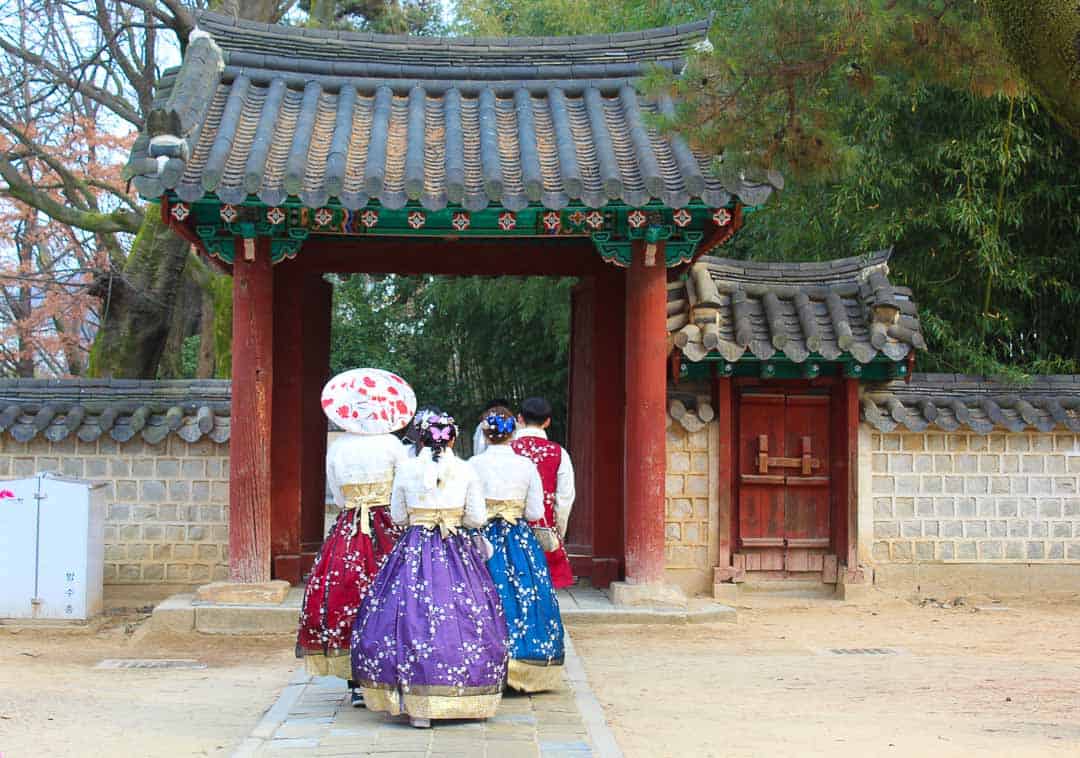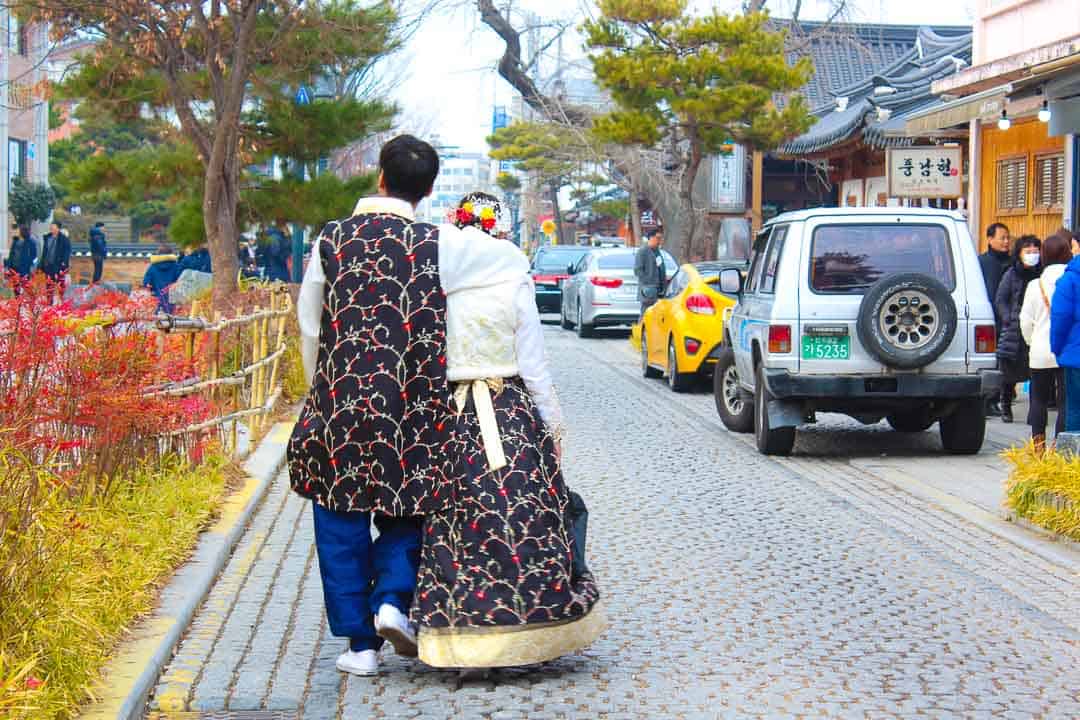8 Amazing Things to Do in Jeonju, South Korea (2022 Guide)
Home | South Korea | 8 Amazing Things to Do in Jeonju, South Korea
From tasting the dish that was listed on Lonely Planet’s “Ultimate Eatlist” to trying out traditional attire and mixing with the locals, these are just some of the best things to do in Jeonju.
 The traditional attire in Jeonju
The traditional attire in Jeonju
In Jeonju, a charming city in South Korea’s south-west, time slows down.
Only less than two hours by train from fast-paced Seoul, entering Jeonju is like being in a time warp.
Besides, the spiritual capital of the erstwhile Joseon dynasty, Jeonju has retained the old school traditions, architecture, and cuisine.
In spite of being knighted as ‘UNESCO City Of Gastronomy’ in 2012, Jeonju has stayed clear from tourism explosion.
READ MORE: Check out our brand new guide to the best things to do in Seoul!
The Best Things To Do In Jeonju
While many come here for day trips, Jeonju is a city that is hard to be understood in a few hours.
With a large number of things to indulge in, here’s our recommendation of 8 experiences to explore Jeonju’s magic.
 Jeonju without its Sakura is as gorgeous
Jeonju without its Sakura is as gorgeous
Set Off In Search Of Jeonju’s Best Bibimbap
There are very few food experiences in the world like a ‘meal in a bowl’ in Jeonju, Korea.
Among the gazillion such bowls, the most celebrated is the ‘mixed rice’ bowl of bibimbap that was born in Korea’s Jeonju.
It is a bowl of rice mixed with shiitake mushrooms, beef, spinach, flavoured with spicy chilli paste, fermented soybean paste, and topped with fried egg.
Trust us, it tastes as stunning as it looks.
As a testament to the quality of the dish, Lonely Planet’s recently released ‘Ultimate Eatlist’ book featured it as the world’s 8th best eating experience.
Almost every restaurant and stall in town have their take on the dish.
Finding your personal favorite is an adventure only Jeonju has on offer.
We recommend the hot pot version at Hanguk-jip, one of the oldest serving institutions.
If you find yourself in Jeonju in October, don’t miss the bibimbap festival that celebrates not just the dish but also other specialties of the region.
 Bibimbap is South Korea in a bowl
Bibimbap is South Korea in a bowl
Live In A Traditional Hanok Home
14th-century traditional Korean homes, Hanoks, epitomise eco-friendly architecture in the modern era of high rise buildings.
Made entirely using natural materials, living inside a Hanok is a reminder of simplistic times.
Jeonju features one of the largest congregation of such houses, featuring close to 800 in a closely knit atmosphere.
Every single thing in Jeonju unravels around the Hanok village, the image you’ll remember Jeonju by.
The best way to surrender yourself to a Jeonju style of living is to spend a few nights inside one of these Hanoks.
Inside a typical Hanok, you will find a comfy futon bed, a Korean style ondol heating system, and absolutely no cluttered furniture.
A couple of nights in a Hanok is a great way to reconnect with the surroundings.
The Jeonju Hanok House is one of the most preferred properties located in the center of the village and it features lovely hosts.
 The view of the traditional Hanok village
The view of the traditional Hanok village
Embark On A Photography Walk Of Mural Village
Located on one of the small hilly pavilions above the Hanok village, the Jaman mural village is a photographer’s delight.
Once a poor hillside village, the introduction of murals on the walls has uplifted the village into a hub of Jeonju tourism.
It’s a delight to photograph the artsy walls more so with locals gathered here in their traditional attire.
Across the bridge from the village, the two pavilions of Omokdae and Imokdae will also keep the photographer in you occupied.
The pavilions are the finest vantage points in the city for a view of the Hanok village.
After satiating your hunger for photography, settle down at the only cafe available in the Mural Village and sip on traditional Korean tea.
 The fairy tale-ish part of Jeonju lies in this Mural Village from city top.
The fairy tale-ish part of Jeonju lies in this Mural Village from city top.
Trace The Forgotten History Of Jeonju
As one of the centres of the Joseon dynasty that ruled over Korea between the 14th and 19th centuries, Jeonju is also an open museum on the rich history of the country.
The Gyeonggijeon shrine built in 1410 houses the portrait of the dynasty’s founder.
Rebuilt in the 1600s after being brought down during a war, the shrine also houses an ancient library.
This library contains unique artefacts and ancestral tablets of the Yi royal family alongside annals from the Joseon dynasty that was one of the few that survived the Japanese invasion.
Korea Tourism organises a guided tour of the shrine that will introduce you to a unique historical side of the city.
One can buy tickets at the counter.
After visiting the shrine, cross the road over to the Jeondong Catholic cathedral, one of the first and oldest Romanesque buildings in the region.
Another survivor of the Japanese invasion, the church is equally stunning from the inside as it is from the outside.
From there on, walk 2 mins towards the Pungnammun gate, the only surviving of the four gates that surrounded the now-defunct castle.
At night, the light show at the gate is a delight to watch.
If you’re into history this shrine should be on your list of things to see in Jeonju!
Don’t miss out on our guide for the best hiking in South Korea!
 The center of all history in Jeonju.
The center of all history in Jeonju.
Indulge In A DIY Gastro-Tour
Of all the things to do in Jeonju, this was our favourite.
Jeonju, the gastronomical capital of Korea is the apt place to unlock the foodie in you.
Dive into the myriad flavours of the country, from spicy to sweet, in the city where everyone is a gourmand.
The pick of the lot is the PNB Choco Pie, that debuted in Jeonju almost 70 years ago.
Filled with cream or strawberry jam, the pie has achieved cult status.
Be warned, a handful of variants of the “pie” is doled out all over Jeonju.
The long queues outside the original should guide you to the right one.
Follow up the pie with the savoury meatball skewer, another crowd favourite, found right outside PNB.
Variants with octopus and shrimp are equally delightful.
Another must-try street food item is Hotteok, Korean sweet pancake, crispy on the outside and filled with sugar syrup.
In the mornings, head to the ‘Jeonju bread cafe’ to taste the handmade bread made of bibimbap ingredients like the sweet red bean bread and wash it down with a cuppa coffee.
If you happen to be in Jeonju on a Friday evening, the traditional Nambu market is the only place to be.
With over a hundred colourful food stalls in a festive atmosphere, you’ll leave with your belly full and satisfied.
This city has great food culture so plan diligently where you want to eat as there are many fantastic places to visit in Jeonju.
 The dilemma of what to eat and what not to is real in Jeonju
The dilemma of what to eat and what not to is real in Jeonju
Dine & Wine In Traditional Korean Style
The Koreans love their makgeolli, a spirit made of fermented rice.
One of the most exciting things to do in Jeonju is the experience of its ‘makgeolli town’, a bar strip that specialises in the drink.
These taverns are like a Korean version of tapas.
You can order a brass kettle of rice wine for the table and the accompanied food is brought alongside.
For each kettle you get, expect a spread of 20+ dishes, each brimming with flavour.
At Chunnyunnuri Bom, a makgeolli town run by the senior citizen club, each dish is packed with a flavourful punch.
Along with banchan, large ginseng soup bowls, grilled fish, stir-fried pork belly are some of the many dishes served.
The more kettles of wine you order, the dishes on the table grow with it.
Don’t worry about the hangover as Jeonju has the perfect cure for it – Kongnamul Gukbap.
It’s a bean sprout soup with rice that you’ll find in the streets in the morning.
On your list of what to do in Jeonju, visiting the makgeoli town is a Jeonju must see.
 The South Korean tapas to go with its Makgeolli
The South Korean tapas to go with its Makgeolli
Shop To Your Heart’s Content
While shopping in Jeonju is incomparable to the atmospheric markets of Seoul, it carries a traditional charm along with the modern.
From world-renowned cosmetic products (a face mask is a must-buy!) to affordable clothing, South Korea is a shopping heaven.
In the century-old Nambu Traditional Market, find everything from silk scarves to dried fish.
Wake up early to catch the best of the market.
The second floor of the market features a Youth Mall, an open terrace brimming with third wave coffee shops and fashion boutiques.
Downtown Jeonju that hosts the popular international film festival is a great place to shop for luxury brands.
Your best buy would be the face masks from Innisfree. It’s one of the more popular Jeonju tourist attractions – you can’t travel to South Korea without buying some skincare!
 The local shopping market in Jeonju.
The local shopping market in Jeonju.
Try On A Hanbok
If you’ve already explored Seoul, you’d have noticed locals and tourists walking around in colourful traditional hanboks.
Jeonju is a more traditional region to try out some hanboks.
Much like the locals, rent one at a local store and feel like a Korean.
While this may seem like an incredibly touristy thing at first, it is what the locals do too.
You can rent a hanbok for around 5000 won (6 AUD) for 2 hours and most stores will help you slip into the attire.
The traditional hanboks are available both for men and women, usually in a complementary pairing.
Choose from either a garish ceremonial dress or a plain everyday dress and click photographs that you’ll remember.
With almost every second person wearing a hanbok, you’ll not be the odd one.
If you wish to learn more about Jeonju attractions, book a full-day guided tour with Klook.
 The locals dressed up in the traditional attire (Hanbok)
The locals dressed up in the traditional attire (Hanbok)
Key Information
- Jeonju is accessible from Seoul via a KTX train ride of about 1.5 hours. One can also get to Jeonju by bus from the Seoul bus station, in about 2 hours.
- We recommend spending 2 nights in Jeonju, preferably over a Friday-Saturday, to make the most of the city.
- Add an additional day if you’ve time on your hands to visit the unique Red Ginseng Spa in Jinan county.
Given the sheer number of fun and unique things to do in Jeonju, it deserves to be on every traveler’s itinerary to South Korea. Chances are you’ll meet the real Korea in this elegant, charming, and forgotten city.
We skipped the crowded Cherry Season for a more local experience during the Winters in South Korea.
DISCLAIMER: Some of the links in this article are affiliate links, which means if you book accommodation, tours or buy a product, we will receive a small commission at no extra cost to you. These commissions help us keep creating more free travel content to help people plan their holidays and adventures. We only recommend the best accommodations, tours and products, and regularly review these. Thanks for your support, kind friend!

